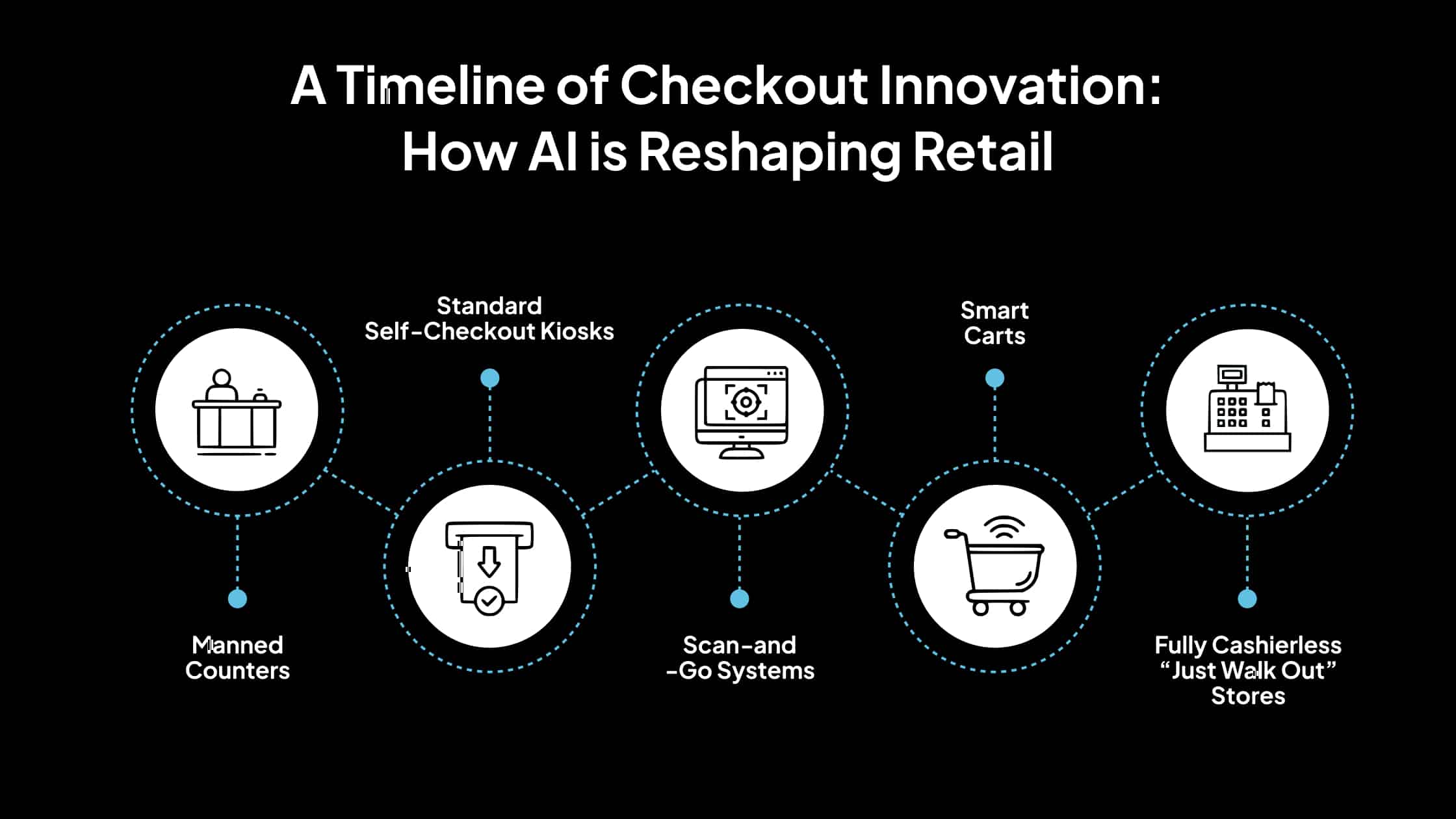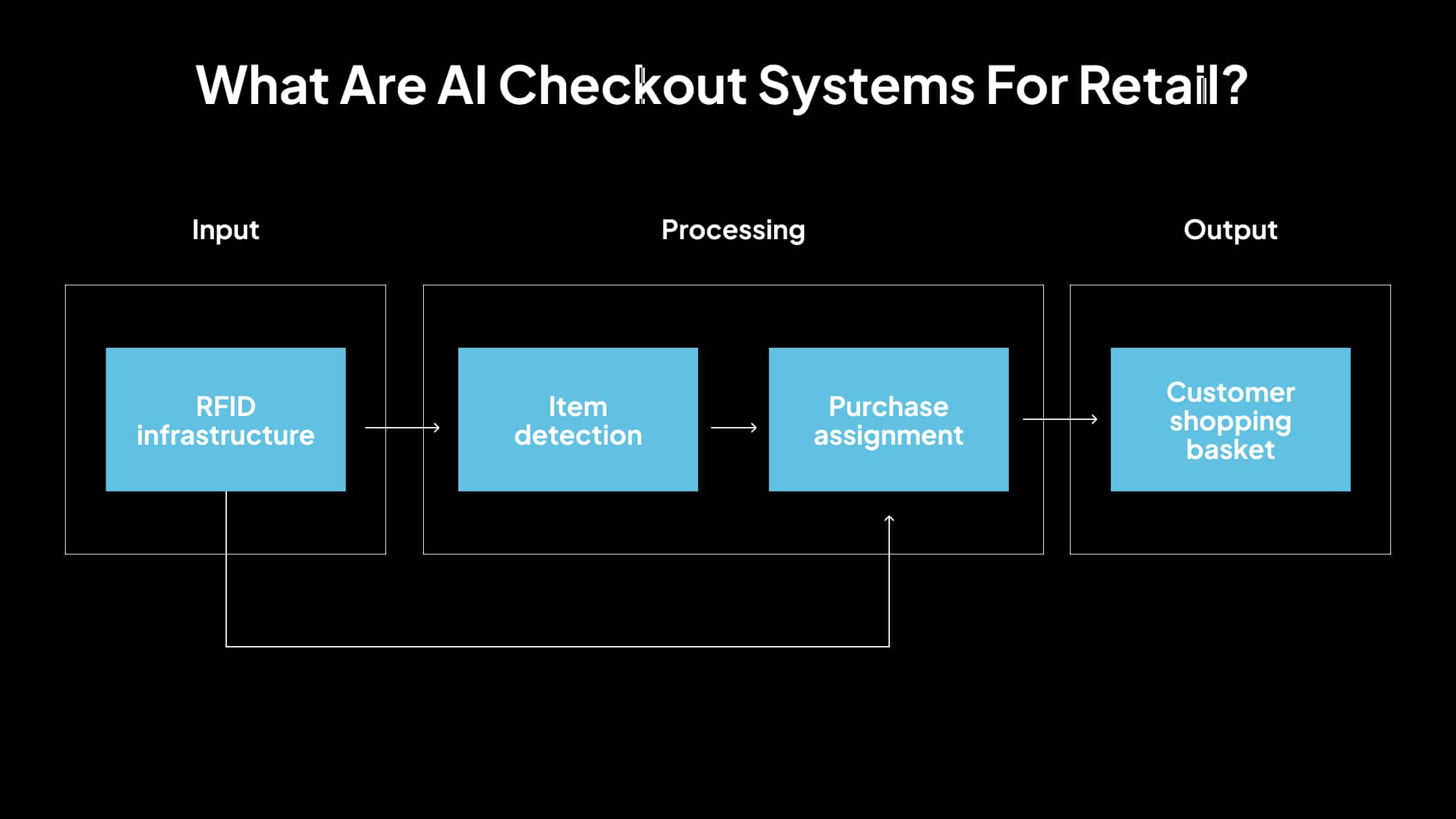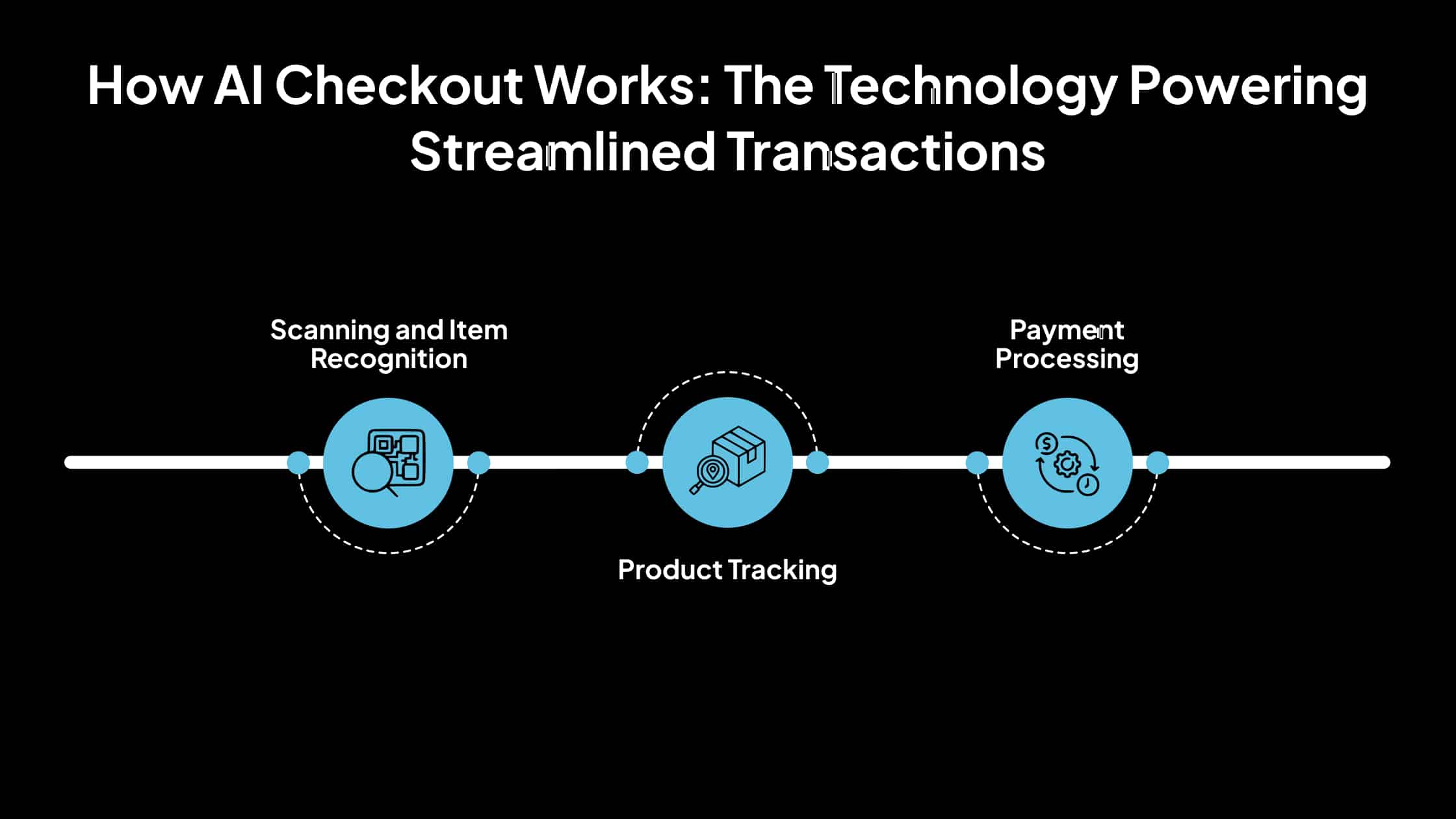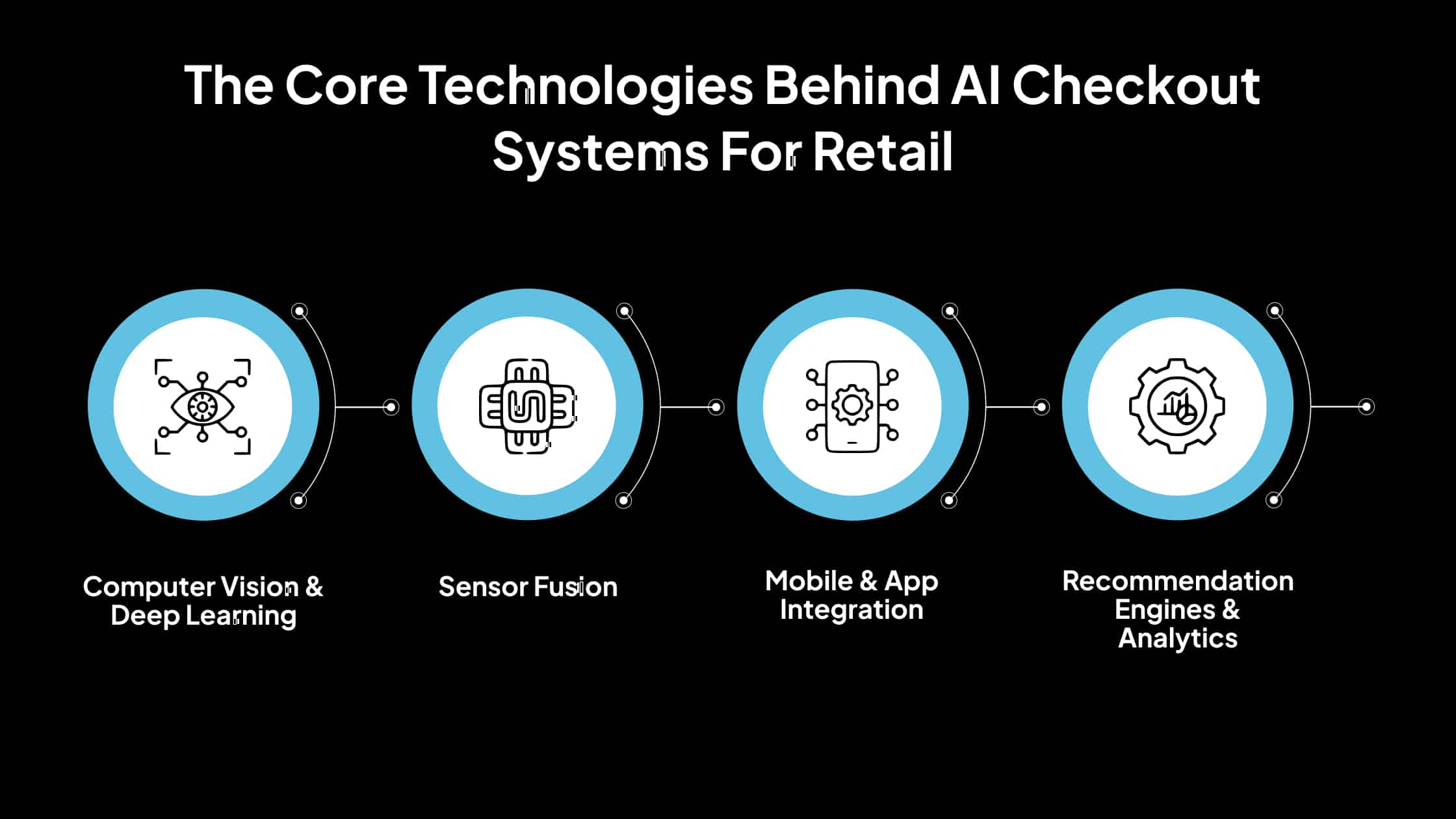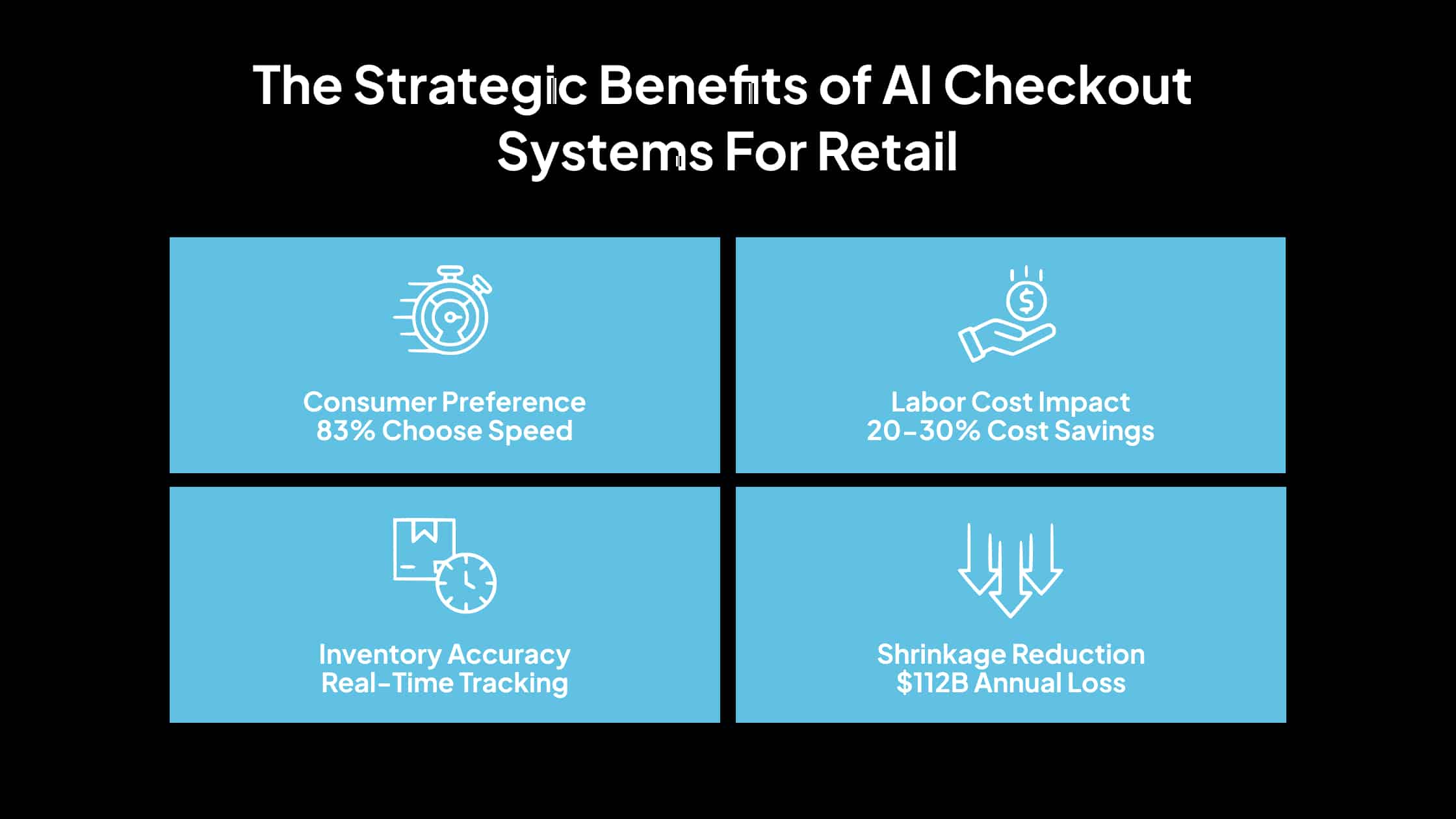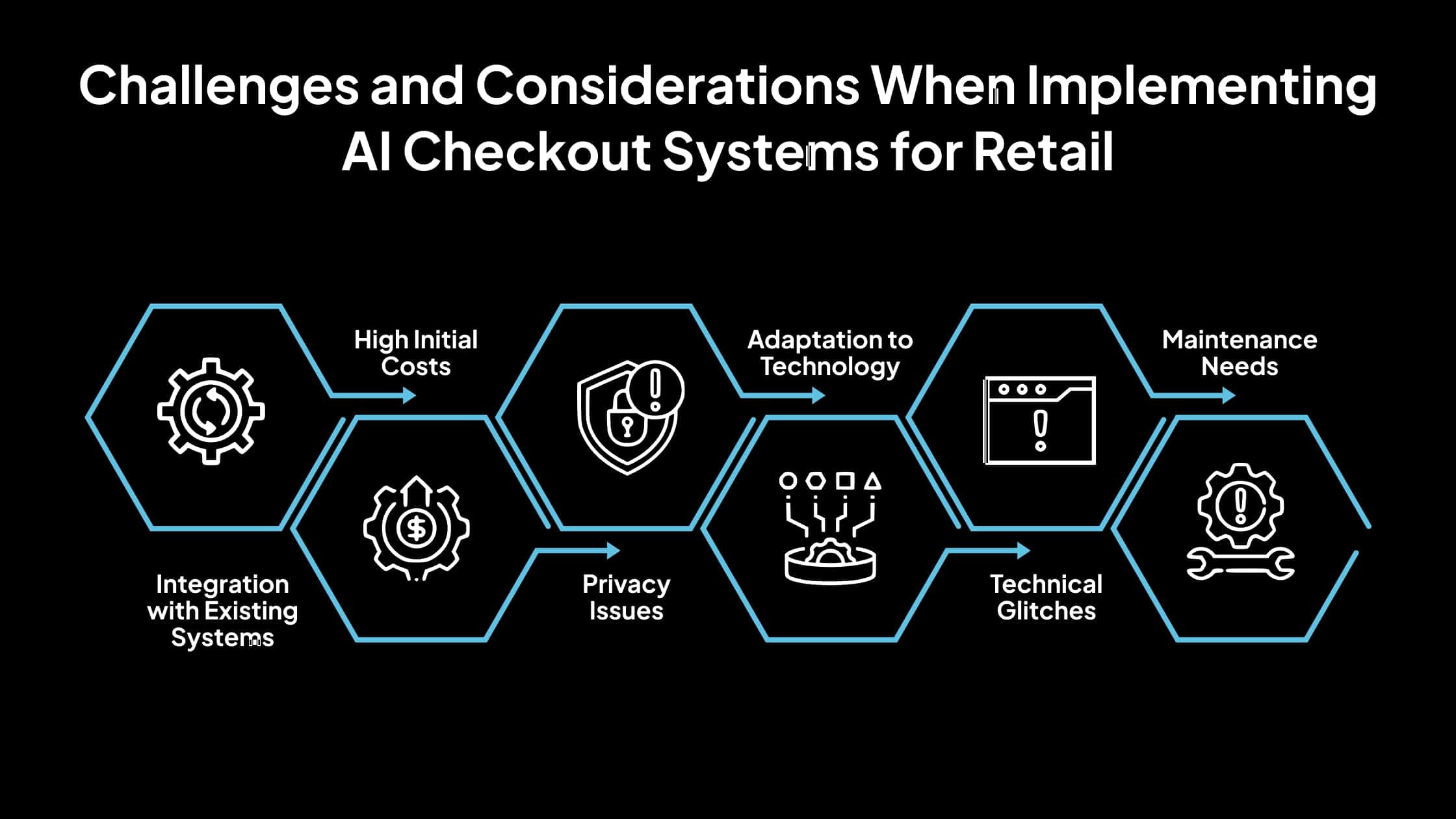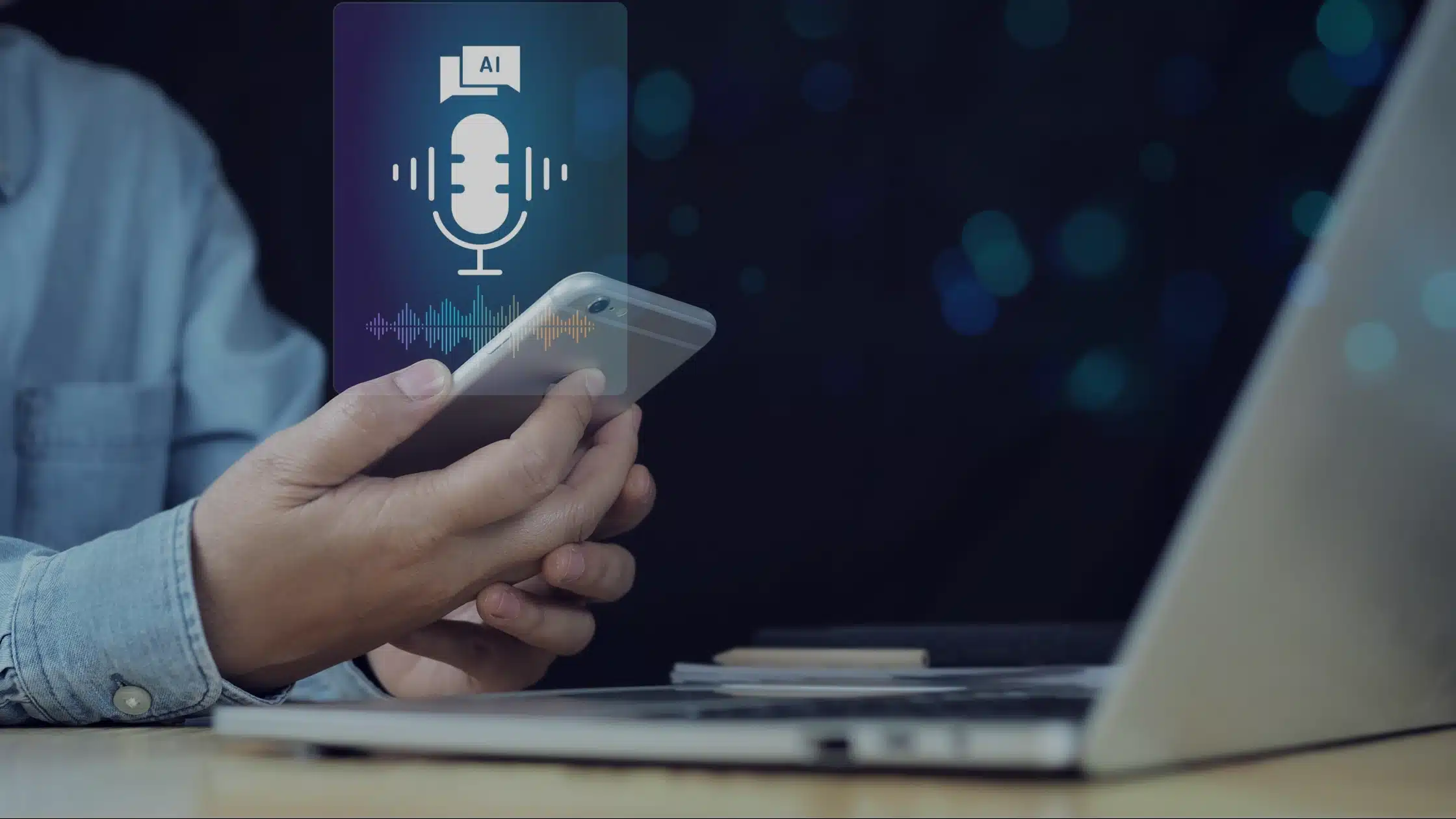If your checkout line is slowing customers down, your bottom line may be taking a hit too.
Today’s shoppers expect speed, convenience, and seamless in-store experiences. Studies show that 86% of consumers abandon a store if the line is too long. AI checkout systems are beginning to reshape the retail experience in this area.
From smart carts to fully cashierless stores, AI checkout systems offer more than just faster transactions. They help retailers reduce labor costs, minimize human errors and shrinkage, and gain real-time visibility into inventory. Additionally, these technologies provide valuable insights into shopper behavior, enabling businesses to make more informed merchandising and operational decisions.
It’s no surprise that global investment in retail AI is accelerating. According to IDC, the overall global Artificial Intelligence market was valued at nearly $235 billion in 2024, with projections indicating a rise to over $631 billion by 2028. Retail is among the top industries investing in AI, software, information services, and banking.
But should your retail business adopt it? The answer isn’t one-size-fits-all. In this blog, we’ll explore the real business case behind AI checkout systems for retail: where the ROI lies, and how to evaluate whether this technology is right for your store.
A Timeline of Checkout Innovation: How AI is Reshaping Retail
Retail checkout has undergone a remarkable transformation, from cashier lanes to the flow of AI-powered systems. Let’s look at the significant milestones that have shaped this evolution and paved the way for a more intelligent in-store shopping experience.
1. Manned Counters
For decades, retail checkout involved a cashier manually scanning items, handling payment, and bagging goods. This model provided customer service and oversight but often led to lengthy queues, especially during peak hours, prompting early thinking around automation.
2. Standard Self‑Checkout Kiosks
The first self-service checkout machine appeared in 1986 at a Kroger supermarket near Atlanta, Georgia. Shoppers scan items, print receipts, and make payments independently at kiosks. By 2025, an estimated 1.2 million self‑checkout units will be globally installed .
These kiosks reduced labor needs and freed staff for other roles. Yet technical glitches, weight mismatches, and theft concerns remain common.
3. Scan‑and‑Go Systems
Shoppers scan items using a handheld device or mobile app while they shop, then pay and leave, without kiosks involved. Big chains like Sam’s Club and Walmart piloted scan‑and‑go as early as 2016 . More recently, Australian supermarkets (e.g., Woolworths, Coles) are testing similar tech, aiming for speed and immediate spend tracking.
These systems offer shoppers transparency over spending and reduce checkout time. However, they depend on customer participation and accurate scanning, so theft risk continues.
4. Smart Carts
Shopping carts embedded with barcode scanners, touchscreens, weight sensors, and payment options enable customers to scan as they shop and skip lines. Caper Carts (by Instacart) and Kroger’s KroGo trial use computer vision and sensor fusion for AI-based checkout . Wegmans recently piloted its smart carts in New York .
This method combines the convenience of scan‑and‑go with automated item verification using visual and weight data. However, the cost of retrofitting carts and accurate detection remains challenging.
5. Fully Cashierless “Just Walk Out” Stores
These stores use computer vision, sensor fusion, and deep learning to detect when items are taken or returned automatically. The customer’s account is charged upon exit, no checkout is required. Amazon Go launched publicly in Seattle in January 2018 and has grown to 43 locations as of 2024.
It provides ultimate frictionless shopping and real-time inventory but requires sophisticated AI. Large-format stores face issues with sensor accuracy and often rely on manual intervention behind the scenes .
What Are AI Checkout Systems For Retail?
AI checkout systems are technology-driven solutions that allow customers to complete their shopping without traditional manual scanning at a cash register. These systems combine cameras, sensors, computer vision, and machine learning algorithms to automatically recognize products and process payments.
Computer vision is at the core of these systems, which identify and track items as customers pick them up or return them. Sensors such as RFID (Radio Frequency Identification) tags, weight sensors, and LiDAR help verify the presence and movement of products. In some advanced implementations, facial recognition or customer identification tools may be used to personalize the experience or link transactions to individual accounts, which raises privacy considerations.
AI systems aim to provide a faster, more seamless shopping experience by automating the item recognition and checkout process, reducing the need for traditional cashier-operated counters.
How AI Checkout Works: The Technology Powering Streamlined Transactions
The AI checkout process generally follows these steps:
1. Scanning and Item Recognition
As the customer selects items, cameras and sensors detect the action. Computer vision algorithms recognize each product and add it to the customer’s virtual shopping cart in the system.
2. Product Tracking
AI continuously monitors the customer’s interactions. If an item is returned to the shelf, it is removed from the virtual cart. Weight sensors and RFID further verify these actions to prevent errors.
3. Payment Processing
Once the customer finishes shopping, the system automatically calculates the total cost. Depending on the store design, payment may occur through:
- An app linked to the customer’s profile
- Contactless payment at a kiosk
- Automatic billing when the customer exits (as in Amazon Go and similar stores)
Throughout this process, AI ensures accurate tracking of both products and customers, minimizing human intervention and streamlining the shopping experience.
The Core Technologies Behind AI Checkout Systems For Retail
AI checkout systems may appear effortless on the surface, but they rely on a complex web of advanced technologies working in perfect harmony.. Let’s explore the essential technologies that make AI-driven checkout possible and practical for modern retail environments.
1. Computer Vision & Deep Learning
Computer vision uses cameras and advanced neural networks (e.g., YOLOv10, YOLOv8) to detect and identify products as customers shop or at checkout counters. Retail-focused systems track item appearance, size, and movement in real-time.
In cashierless stores like Amazon Go or Trigo-powered outlets, deep learning processes hundreds of video frames per second, associating each product with a shopper to update their virtual cart instantly .
2. Sensor Fusion
Sensor fusion combines data from multiple sources, such as weight scales, RFID tags, LiDAR, and cameras, to increase accuracy and reduce errors.
For instance, weight sensors confirm if an item was taken, RFID can auto-scan tagged merchandise, and LiDAR maps spatial movements. By integrating these readings, systems triangulate better and catch inconsistencies, reducing mischarges and inventory mismatches .
3. Mobile & App Integration
Scan-and-go systems use smartphone apps (store-provided scanners) to scan barcodes or SDKs like Scandit’s to capture images. The checked items populate a live basket in the app, which handles payment and loyalty integration .
At exit, app-generated QR codes or NFC signals tie purchase data to the customer and finalize payment, enabling frictionless egress .
4. Recommendation Engines & Analytics
AI-based recommendation systems use collaborative filtering, content-based filtering, and session-based models (e.g., LSTM, Transformers) to suggest products in real time. Retailers utilize platforms like Google Vertex Recommendations and Adobe Sensei to analyze purchase history, in-store behavior, and demographics to optimize layouts, promotions, and cross-sells.
On the operations side, ML models (e.g., GRU-based forecasting) predict demand, restocking needs, and staffing levels, boosting efficiency and reducing waste.
The Strategic Benefits of AI Checkout Systems For Retail
AI checkout systems for retail are transforming how stores operate and consumers shop. By automating the checkout process, these systems deliver significant advantages for both customers and retailers. Below are the essential benefits driving their growing adoption:
1. Enhanced Customer Experience
AI checkout systems eliminate long waits at traditional cashier lines. Shoppers can scan items or use cashierless options to check out instantly. According to a Deloitte report, 83% of consumers cite convenience and speed as their top reasons for using automated checkouts.
Whether through scan-and-go apps, smart carts, or cashierless stores, AI checkout systems allow customers to shop at their own pace. They can pick up items and exit without being slowed by traditional processes. This seamless experience is particularly appealing to time-pressed urban shoppers.
Modern consumers increasingly value ease and efficiency in their shopping journeys. AI checkout systems for retail meet this demand by removing unnecessary steps and creating a frictionless path from shelf to exit.
2. Improved Operational Efficiency
Automation reduces the number of staff required at checkout counters, freeing employees for higher-value tasks such as customer service and store upkeep. McKinsey estimates that automation could reduce retail labor costs by 20–30% in the coming years.
AI-powered systems precisely track product movements, providing retailers with real-time insights into stock levels. This improves inventory accuracy, reduces stockouts, and enhances replenishment planning, ultimately improving overall store performance.
3. Reduced Human Error and Theft
Manual checkouts are prone to errors, such as mispriced items or missed scans. AI checkout systems use advanced computer vision and sensors to detect and track items accurately, significantly reducing such mistakes.
Retail shrinkage is a primary concern, with global retail shrinkage totaling $112 billion annually. AI checkout systems for retail help combat this by ensuring all items are tracked and verified before leaving the store. Some systems also use AI-powered video analytics to detect real-time suspicious behavior.
4. Cost Savings for Retailers
By automating the checkout process, retailers can operate with fewer cashiers and attendants. This helps manage labor costs, especially during off-peak hours when staffing checkout lanes may not be cost-effective.
Self-checkout kiosks and AI-driven cashierless systems typically require less physical space and fewer maintenance resources than traditional staffed checkout lanes, contributing to lower overhead expenses.
While the initial investment in AI checkout systems for retail can be significant, the long-term return on investment is substantial. Retailers report gains in operational efficiency, labor cost savings, and higher customer satisfaction, leading to improved loyalty and sales.
Challenges and Considerations When Implementing AI Checkout Systems for Retail
While AI checkout systems for retail offer clear advantages, their implementation also comes with essential challenges that retailers must carefully consider. Here is a list of a few of these challenges:
1. Integration with Existing Systems
Many retailers operate on legacy point-of-sale (POS) and inventory systems that are not designed to work with AI-driven checkout technologies.
Integrating AI checkout systems for retail with these older platforms can be complex and may require significant customization or upgrades. Without proper integration, retailers risk data silos, system conflicts, or degraded performance.
2. High Initial Costs
Deploying AI-powered checkout systems, whether kiosks, smart carts, or cashierless store technology, requires substantial upfront investment. Costs include hardware, software development, store remodeling, and staff training.
This can be a barrier to adoption for smaller retailers or those with tight margins. However, many retailers view this investment as a long-term investment in efficiency and customer experience improvements.
3. Privacy Issues
AI checkout systems for retail often rely on computer vision, sensors, and data collection to track shopping behavior. This raises concerns among some customers about how their data is collected, used, and stored.
Transparency around data practices, precise opt-in mechanisms, and robust data protection measures are essential to building consumer trust.
4. Adaptation to Technology
Not all customers are comfortable using AI-driven checkout systems. Older shoppers or those less familiar with mobile apps or automated interfaces may find the new process intimidating or inconvenient.
Retailers must balance innovation with accessibility, often by maintaining a mix of AI-powered and traditional checkout options to serve all customer segments.
5. Technical Glitches
AI checkout systems depend highly on technology, including sensors, software algorithms, and connectivity.
System malfunctions, power outages, or software bugs can disrupt the checkout process, potentially frustrating customers and causing operational delays. Robust IT support and contingency planning are critical to minimize downtime.
6. Maintenance Needs
AI checkout systems for retail require ongoing maintenance to remain effective. Hardware components like cameras and sensors must be kept clean and functional, and software requires regular updates to ensure accuracy and security. Neglecting maintenance can lead to decreased system reliability, which can impact customer experience and store performance.
Global Adoption and Practical Applications of AI Checkout Systems for Retail
The adoption of AI checkout systems for retail is growing rapidly across the globe. Leading retailers invest in these technologies to enhance customer experience, improve efficiency, and stay competitive. Here are several real-world examples that showcase how AI checkout systems are being successfully implemented:
1. Wesco’s Implementation
Wesco, a regional grocery chain based in Michigan, has adopted Mashgin’s AI-powered self-checkout kiosks across its stores. These kiosks use computer vision to instantly identify multiple items placed on a scanning surface without the need for barcodes.
As a result, Wesco has significantly reduced transaction times and improved overall customer satisfaction. Shoppers now experience faster checkouts with minimal waiting, while the store benefits from smoother operations and increased throughput.
2. Sam’s Club’s AI Exit Technology
Sam’s Club, a division of Walmart, has implemented AI-powered exit technology in its stores to eliminate the need for manual receipt checks. Earlier, customers had to wait for an associate to verify their receipts at store exits.
With the new AI system, cameras and computer vision verify the items in the cart automatically as customers pass through the exit, ensuring that all items are accounted for. This innovation speeds up the shopping process, reduces congestion at exits, and enhances convenience for members.
3. Tesco’s VAR-Style AI Cameras
UK-based retail giant Tesco has deployed VAR-style AI cameras at its self-checkout stations. These cameras monitor the checkout process in real time to detect items that may not have been scanned.
The system acts as a second layer of verification, helping to reduce shrinkage due to theft or scanning errors. Tesco reports that this AI technology improves checkout accuracy while maintaining a positive customer shopping experience.
4. Instacart’s Caper Carts
In select stores in New York City, Instacart has introduced Caper Carts, AI-powered smart shopping carts equipped with cameras, weight sensors, and a touchscreen display.
The cart automatically identifies and adds items to a virtual receipt as customers shop. When shopping is complete, customers can pay directly through the cart, bypassing traditional checkout.
Evaluating AI Checkout: Is It the Right Move for Retailers?
As AI checkout systems for retail continue to evolve, many retailers are asking an important question: Is now the right time to adopt this technology? The answer depends on several factors, including return on investment (ROI), store type, customer expectations, and operational readiness. Let’s explore the considerations that can help guide this decision.
1. Evaluating the ROI
Before adopting AI checkout systems, retailers must carefully evaluate the potential return on investment:
Cost vs. long-term savings
Initial setup costs can be significant, including hardware, software, integration, and staff training. However, over time, AI checkout systems can deliver cost savings through reduced labor needs, improved efficiency, and lower shrinkage.
Although initial setup costs (hardware, software, integration, training) are high, real-world data shows significant gains. A 2024 NVIDIA survey reported 72% of retailers using AI have seen a decrease in operating costs, 28% reported reductions of 5–15%, and 23% saw reductions above 15%.
Customer satisfaction
A Gitnux study in 2023 found that 72% of consumers prefer self‑checkout over staffed lanes, signaling strong demand for efficient, tech-enabled shopping experiences.
Faster, more seamless checkout processes can increase customer satisfaction and loyalty. Retailers should assess whether their customer base values convenience and self-service options.
Competitive advantage
Early adopters of AI checkout systems may gain an edge in markets where innovation and customer experience drive brand preference. McKinsey observes that businesses adopting AI for store operations, such as queue analytics and theft prevention, gain efficiency and market differentiation. Modern checkout options can differentiate a retailer from competitors still using traditional systems.
Recommendations for Retailers
Large retailers with high transaction volumes and multiple locations often see the strongest ROI from AI checkout systems, due to greater labor savings and operational efficiencies at scale.
Small and midsize retailers should assess their specific needs and customer demographics. For some, lighter AI solutions such as scan-and-go apps or self-checkout kiosks may provide a more affordable and practical starting point.
Essential Factors to Consider Before Adopting
|
AI checkout systems for retail represent a fast-growing trend that has the potential to reshape how stores operate and how customers experience shopping. Adopting these systems offers clear benefits for retailers: improved efficiency, enhanced customer satisfaction, and long-term cost savings. However, successful adoption requires a thoughtful balance between innovation, privacy, customer comfort, and operational readiness.
The retail industry is at an inflection point; those who invest strategically in AI checkout systems today will be well-positioned to meet the expectations of tomorrow’s shoppers.
Discover Avahi’s AI Platform in Action
At Avahi, we empower businesses to deploy advanced Generative AI that streamlines operations, enhances decision-making, and accelerates innovation—all with zero complexity.
As your trusted AWS Cloud Consulting Partner, we empower organizations to harness AI’s full potential while ensuring security, scalability, and compliance with industry-leading cloud solutions.
Our AI Solutions include
- AI Adoption & Integration – Utilize Amazon Bedrock and GenAI to enhance automation and decision-making.
- Custom AI Development – Build intelligent applications tailored to your business needs.
- AI Model Optimization – Seamlessly switch between AI models with automated cost, accuracy, and performance comparisons.
- AI Automation – Automate repetitive tasks and free up time for strategic growth.
- Advanced Security & AI Governance – Ensure compliance, fraud detection, and secure model deployment.
Want to unlock the power of AI with enterprise-grade security and efficiency? Get Started with Avahi’s AI Platform!
Frequently Asked Questions
1. What are AI checkout systems for retail and how do they work?
AI checkout systems for retail use technologies like computer vision, sensors, and machine learning to automate the checkout process. They enable customers to scan items via apps, use smart carts, or even walk out without visiting a traditional checkout counter—improving speed, reducing labor costs, and enhancing the shopping experience.
2. What is the ROI of implementing AI checkout systems for retail?
The ROI of AI checkout systems for retail depends on store size and sales volume. Many retailers report labor savings, lower shrinkage, and improved customer satisfaction. Larger chains often see faster ROI, but small and mid-size retailers can also benefit through selective AI adoption such as scan-and-go apps or self-checkout kiosks.
3. Are AI checkout systems for retail suitable for small businesses?
Yes, but the approach needs to be scaled. While fully cashierless stores may be better suited for large retailers, AI checkout systems for retail can be adopted in smaller formats through affordable tools like AI-powered self-checkout kiosks or mobile scan-and-go apps—helping small businesses compete on convenience and efficiency.
4. How do AI checkout systems for retail impact customer experience?
AI checkout systems for retail improve customer experience by enabling faster, frictionless checkouts and reducing wait times. They also support hybrid shopping models, giving customers options (self-checkout, smart carts, cashierless exits) while freeing up staff for more personalized service. However, success depends on thoughtful rollout and customer communication.
5. How do AI checkout systems for retail integrate with existing POS systems?
Modern AI checkout systems for retail are designed to integrate with leading POS and inventory management platforms via APIs. Integration ensures real-time syncing of sales data, inventory levels, and customer transactions, which is essential for delivering a seamless shopping experience and accurate reporting.

